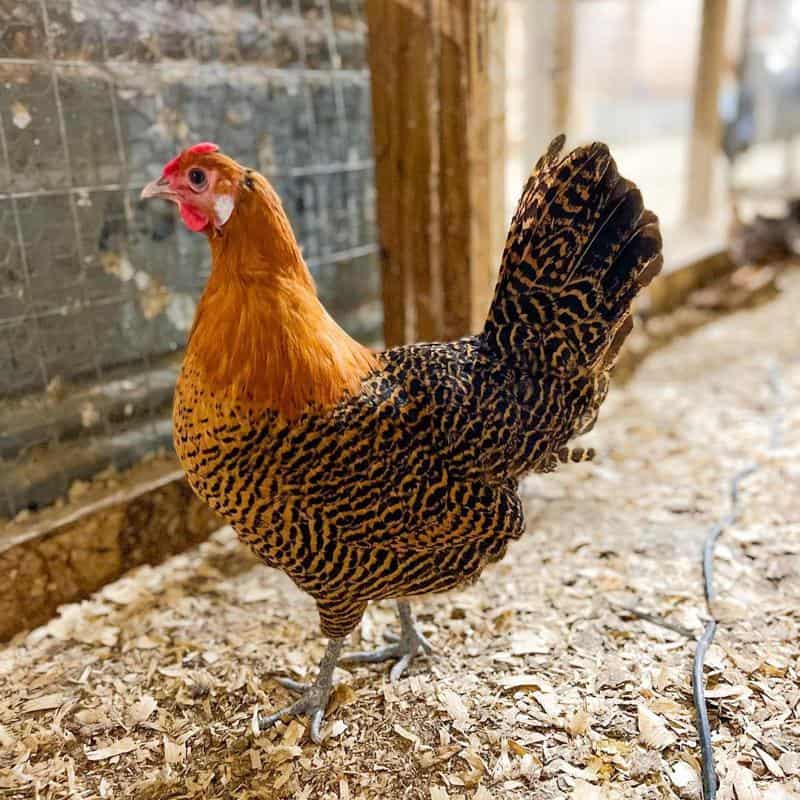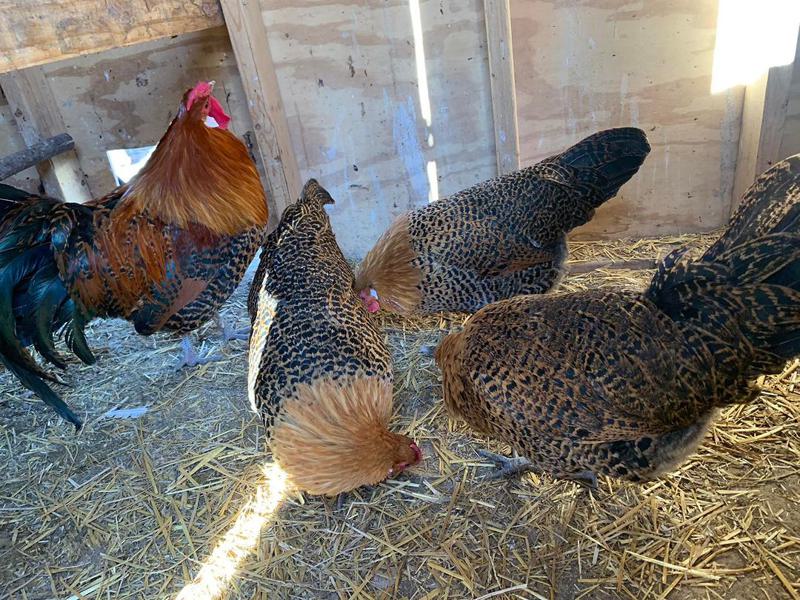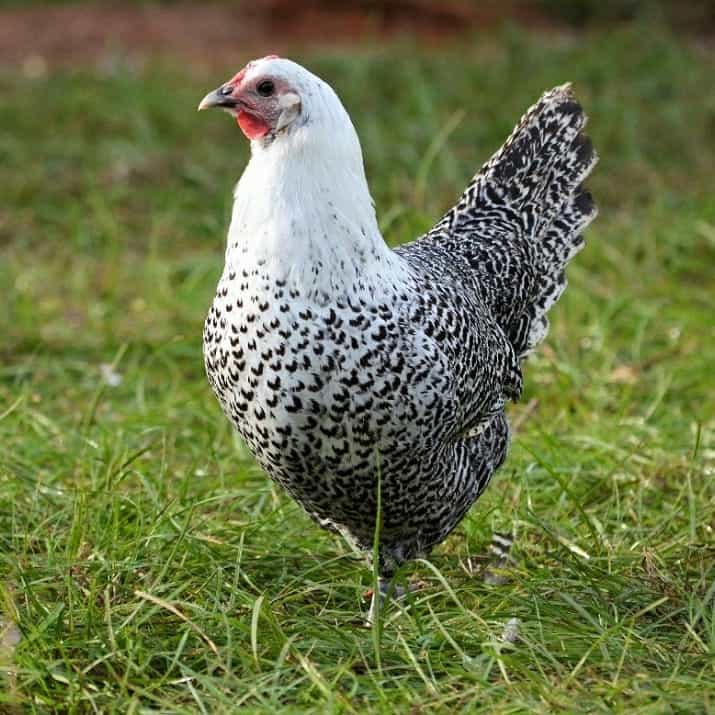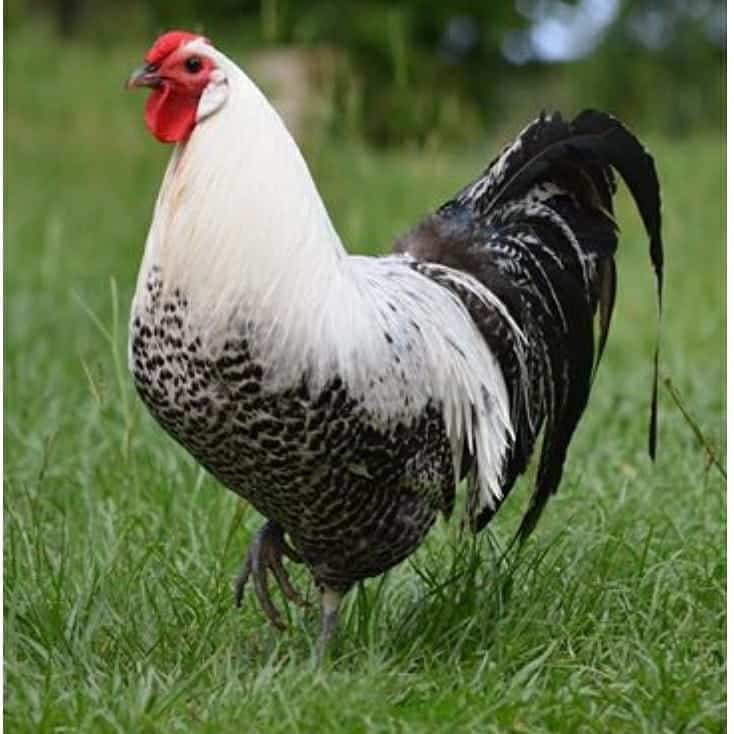No one knows exactly how Deathlayer chickens got their names, but we can all agree that as far as chickens go, no other breed has a name that is more hardcore.
Despite the cool name, Deathlayer chickens are on the list of gravely endangered breeds in Germany.
Like many ancient chicken breeds, this breed has been quickly pushed out by modern ones and you may have to work harder to get your hands on one. The number of Deathlayer chickens currently in existence is quite low.
Raising Deathlayer chickens doesn’t call for anything specialized. Their personality may still make it challenging to raise them in a confined setting.

This chicken breed’s appearance is quite unique and even after it was overtaken by other breeds in its primary purpose, it was still used as a show bird. You certainly won’t mind showing this bird off to anyone who comes to see your farm.
Raising Deathlayer chickens can give you the chance to participate in the preservation of a chicken breed with a longer history than most. Find out what this special bird is all about and why the breed is worth preserving on our farms.
Deathlayer Chicken Quick Facts
| Names | Westfälischer Totleger, Deathlayer, Doutleijer |
| Origins | Westphalia, Germany |
| Primary Purpose | Egg Production |
| Egg Production | Mid |
| Climate | Cold and Heat Tolerant |
| Personality | Shy |
| Weight | Roosters: 5.5 lbs.
Hens: 4.4 lbs. |
| Interesting Facts | Egg production does not taper off later in life. |
History of the Deathlayer Chicken
Origins
For certain breeds of chicken, it is possible to say the exact year when the breed first came into existence. Unfortunately, as with many historic breeds, the same can’t be said for the Deathlayer chicken.
What is known about the Deathlayer breed is that it has been in existence for more than 4 centuries. This is impressive because even the famous Rhode Island Red has only been around since the 1870s.
Not much is known about the early years of the Deathlayer Chicken. It is believed to have come from chickens that were originally found in rural Westphalia.
The Braekel breed from Belgium and the German Ostfriesische Möwe are both closely related to the Deathlayer.
Deathlayers were mostly kept by farmers in Herford and Bielefeld. These are cities in the North-Rhine Westphalia region in Germany.
Name
One of the most controversial facts about the Deathlayer chicken is its name. It is commonly thought that the name means these chickens lay eggs until they die but this is not accurate.
The Germanic name of Deathlayers is Westfälischer Totleger and ‘Totleger’ is now translated to ‘dead layer’. However, it is said that the name ‘Totleger’ came about when the chicken’s original name was changed from ‘Dauerleger’ to ‘Doutleijer’ and finally to ‘Totleger’.
These changes to the name were due to the evolution of the language spoken in Germany.
The original name of this chicken breed ‘Dauerleger’ or ‘Alltagsleger’ meant ‘everyday layer’. This was a reference to the egg-laying consistency of this breed throughout its life.
Decline
Deathlayer chickens were popular in their native country until the late 1800s. This period marked the arrival of chicken breeds from other countries.
Deathlayers could not compete with these new layers and their presence rapidly declined.
A Deathlayer breeders’ association came about in 1904 but even by that time, the primary purpose for keeping Deathlayers was for exhibition purposes and not for eggs. For much of the 1900s to date, the number of Deathlayers has remained low even within Germany.
Deathlayer Chickens Appearance
Plumage Color and Pattern
One of the reasons why Deathlayer chickens were able to become show birds is their unique appearance.
There are two varieties of Deathlayer chickens with regard to plumage. These are the Gold Penciled Deathlayer chicken and the Silver Penciled Deathlayer chicken.
The pencil refers to the feather pattern which is similar to the laced pattern seen in other chicken breeds.
The males of the Deathlayer breed have a cape. This is a collection of solid-colored feathers that drapes down from their heads to their backs.
The feather pattern changes to the penciled one from their backs to the rest of their bodies. The feathers on the head and necks of the hens are also solid-colored but the effect is less dramatic.
The black feathers on the males of this breed are iridescent, displaying colors like purple and green.
Size
The males of the Deathlayer breed have a maximum weight of around 5.5 pounds. This is low compared to other breeds, demonstrating this breed’s poor potential for meat production.
The hens are even smaller, peaking at around 4.4 pounds at maturity.
Others
Deathlayer chickens have rose combs and wattles that are red. The tighter comb suites the colder climates of the region that this breed is mainly located in.
These chickens also have beautiful black eyes that stand out well against the brighter colors of the roosters.
Uses of Deathlayer Chickens
Egg-Laying
The original purpose of Deathlayer chickens around the farm is right in the name. This chicken breed had a reputation for being a very reliable layer.
There were claims that Deathlayers could produce an egg every day until the day they died. Current information states that this breed can produce around 180 and 200 eggs in a year which is still an impressive output.
The eggs produced by Deathlayer chickens are white or off-white in color. The eggs are mid-sized.
Although they can’t guarantee an egg every day, 180 to 200 eggs every year is still a good output for a backyard chicken.
Other Uses
The small size of Deathlayers means they don’t yield much meat when slaughtered. If you’re looking for a meat bird, you can do better.
However, their luxurious colors and the capes on the roosters give them a lot of potential as show birds.
As great as it would be to have a bird called a Deathlayer as a companion, this breed is unlikely to become a good pet. Deathlayers are active and free-spirited and would much rather roam in an open garden than sit quietly beside you.
Rearing Deathlayer Chickens

Environment and Housing
Deathlayer chickens are not well suited for confinement due to their high energy levels. These chickens will need room to roam and forage if they are to be kept happy.
These chickens also love to roost on tree branches. This may be a tough ask if you don’t have one of these in your backyard.
Deathlayers are hardy and they can cope well with both high and low temperatures. The regions that these birds originate from can get quite cold hence they even have smaller combs than other chickens.
Despite their hardiness, you should still try to provide them with a comfortable environment. A stressful environment will lower Deathlayers’ egg-laying capacity.
Their coop should also be kept clean and well-ventilated, especially during summer.
Diet
Deathlayer chickens love to forage which is one reason why they need plenty of space wherever you keep them. Foraging means their diet will consist of a wide variety of things they can get their beaks on including insects and grass.
Due to their active nature, it’s a good idea to supplement whatever they forage on with a commercial feed. This will ensure your chickens are getting a balanced diet and supplements to protect them from diseases.
Occasional treats for your Deathlayer chickens are also great for maintaining a stress-free environment and these can be things like mealworms, cracked corn, and sunflower seeds.
As stated earlier, these birds are quite active so be sure they always have access to clean drinking water when they need it.
Temperament
It is said that Deathlayer chickens are not as domesticated as other chicken breeds, and this may explain why they can be a little skittish around people.
It’s important to get the chickens accustomed to your presence because if they’re constantly unsettled around people, it can affect their productivity. Luckily, despite their hardcore names, Deathlayer chickens show very little aggression toward people.
Lifespan
When reared in a suitable environment with limited sources of stress, Deathlayer chickens can live for 12 years.
Modern chickens used for commercial egg production are rarely kept beyond 3 years due to the sharp decline in egg production. Hens raised as part of backyard flocks can reach 8 years, producing eggs for 3 or 4 years.
What is special about Deathlayer chickens is that their egg production remains consistent throughout their long lives.
Brooding
If you are planning on hatching the eggs from your Deathlayer chickens, you’ll need to find an alternative solution because the hens of this breed are not known for sitting.
You may have to get another chicken breed that is more likely to go broody or use an incubator to hatch your chicks.
Endangered Status
One issue that constantly comes up with regards to Deathlayer chickens is their endangered status and there is a good reason for this.
As of 2016, it was estimated that there were only 176 male and 798 female Deathlayer chickens in Germany. These numbers are frighteningly low, especially for a breed that has the qualities of the Deathlayer.
There have been efforts to save the breed, and some have been exported to the United States starting in 2016. Both the Gold and Silver Penciled variants of the Deathlayer are currently available in the US.
Due to their rarity, it can take a little bit of time and money before you can add one of these chickens to your flock.
Also Read:
Many Reasons to Choose the Deathlayer
When you’re thinking of starting a backyard flock or just looking to add one more bird to the group, you won’t be short of options. It may be difficult to get your hands on one right now but there are many reasons why the effort to get a Deathlayer will be worth it.
For starters, these birds can produce as many as 200 eggs every year from the time they start laying to the time they die without a decrease in egg production. This is great considering Deathlayers can outlive many other backyard breeds.
Deathlayer chickens are foragers and will not only rely on you to feed them and this can help to keep the cost of feeding your chickens low. These birds are also active, and you may enjoy watching them walk around your farm trying to get their beaks on something.
The roosters of this breed are a colorful bunch with features that are well-suited for exhibition. You may end up with a champion show bird if you get a Deathlayer.
Lastly, and perhaps more importantly, despite their immense potential, this breed of chicken is currently at risk of going extinct. Choosing to rear a Deathlayer chicken will help to preserve the legacy of this breed and ensure its benefits are enjoyed for many years to come.


